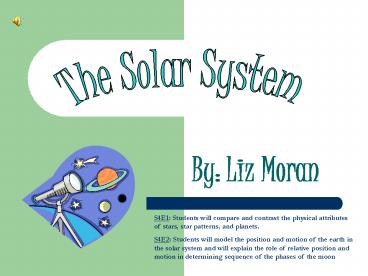By: Liz Moran - PowerPoint PPT Presentation
1 / 22
Title:
By: Liz Moran
Description:
By: Liz Moran S4E1: Students will compare and contrast the physical attributes of stars, star patterns, and planets. S4E2: Students will model the position and motion ... – PowerPoint PPT presentation
Number of Views:126
Avg rating:3.0/5.0
Title: By: Liz Moran
1
The Solar System
- By Liz Moran
S4E1 Students will compare and contrast the
physical attributes of stars, star patterns, and
planets. S4E2 Students will model the position
and motion of the earth in the solar system and
will explain the role of relative position and
motion in determining sequence of the phases of
the moon.
2
Table of Contents
- What is the Solar System?
- Stars
- Planets
- Moons
- Space Exploration
3
What is the Solar System?
- The solar system is a group of objects in space
that move around a central star (sun). - Includes planets, asteroids, moons and comets
4
Stars
- Stars are burning spheres of gases.
- Even though they look small from Earth, they are
enormous.
5
Star Patterns
- Constellations are names for groups of stars that
appear to form shapes in the sky. They were given
their names many hundreds of years ago to help us
remember which stars are which. We use
constellations to divide up the sky finding one
can help us find another because constellations
move so slowly that, in our lifetime, they will
always be found in about the same place.
6
The Sun The Biggest Star
- The biggest star in the solar system is the sun.
- The sun is the largest object in the solar
system. - The sun is more than 1 million kilometers long.
7
The Nine Planets in our Solar System
8
Planet Temperatures
- Since all planets revolve around the sunthey are
all different distances away. - The farther the planet is away from the sun, the
colder it will be.
Planet Temp. (C)
Mercury 150
Venus 450
Earth 0
Mars -50
Jupiter -150
Saturn -190
Uranus -210
Neptune -230
Pluto -250
9
Planets Distance from the Sun
10
Mercury
- Closest planet to the sun
- About the size of the Earths moon
- No atmosphere
- Mercury virtual tour
11
Venus
- Second planet from the sun
- Very dry atmosphere
- Venus virtual tour
12
Earth
- Our wonderful planet is the third planet from the
sun - Has water and volcanoes
- Only planet with known life
13
Mars
- Fourth planet from the sun
- Known as the red planet because of the color of
its soil - Has the largest volcano in the solar systemMons
Olympus - Mars virtual tour
Click here to go back to the nine planets site
14
Jupiter
- Fifth planet from the sun
- Largest planet in the solar system (3 Earths
would fit inside of it) - Very active gas atmosphere, almost like a
hurricane - Jupiter virtual tour
15
Saturn
- Sixth planet from the sun
- Known for its rings, which can be seen from
Earth with a telescope - Saturn virtual tour
16
Uranus
- Seventh planet from the sun
- Most distant planet you can see without using a
telescope - Has faint rings
- Uranus virtual tour
17
Neptune
- Eighth planet from the sun
- Neptune virtual tour
18
Pluto
- Planet farthest away from the sun
- Smallest planet
- Rocky surface surrounded by frozen gases
- Pluto virtual tour
19
Number of Moons on Each Planet
Each planet has a different number of moons.
Mercury and Venus have zero.
20
Phases of Earths Moon
- The moon does not give off its own light.
Instead, it reflects light from the sun. Half of
the moon always faces the sun and so is always
lit. As the moon moves through its orbit,
different amounts of its lit half can be seen
from Earth. Thats why the moon seems to have
different shapes or phases. The moons cycle of
phases takes about 28 days to complete.
Phases of the Moon Diagram (Earth is in center
white part of each moon is the visible part).
21
Space Exploration
- Since the planets and stars are so far away, we
need special tools to view them. We can use
telescopes from Earth, but to view them up close
we need to go closer. - Astronauts can explore the universe up close
using space probes to examine different planets
and the Earth from afar.
Space ship launching
telescope
22
Continue your Journey in Space
- The Solar System is a wonderful and exciting
thing to discover. There are many sites online
to visit and learn much more. Here are a few - http//www.enchantedlearning.com/subjects/astronom
y/planets/ - http//kids.msfc.nasa.gov/ -































